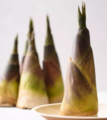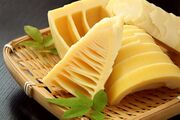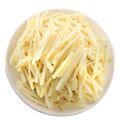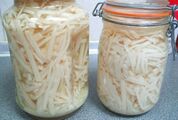Course:FNH200/Projects/2022/Instant Luosifen (river snail rice noodle)
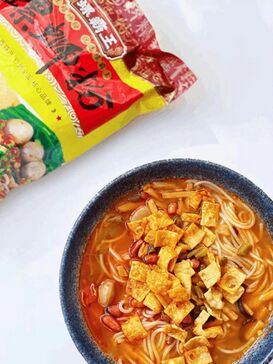
Introduction and History
Luosifen, also known as River Snail Rice Noodles in English, have been the hottest specialty on Chinese social media in recent years. People are very polarised about Luosifen, just like durian, those who like it go crazy for it, while those who can't accept it shun it, and the reason for this is the distinctive smell it carries. The distinctive odour of snail noodles is so strong that it can fill the whole restaurant and surrounding streets with a peculiar sour smell. The soup base is usually made of river snail, pork bones and various spices (such as sorrel, star anise, cinnamon and cloves), combined with rice noodles and various toppings (such as fermented bamboo shoots, yuba and peanuts) to create an overall spicy, umami and sour flavour mix.
Liuzhou, one of the cities in China, has a long history of eating river snails and rice noodles, and as a result, Luosifen was born. Initially, due to problems with the production process and food preservation, snail noodles were only used as a street snack for local recreation. However, in recent years, with technological innovations in preservation, a new type of pre-packaged Luosifen (instant packs similar to instant noodles) has become popular. And due to the promotion of social media and the effects of COVID-19, more and more young people who dare to try new things have experienced and fallen in love with the unique taste of Luosifen. Our team will take the pre-packaged Luosifen as an example, and analyse its flavour origin, nutritional value, packaging and how it compares to other products in its category.
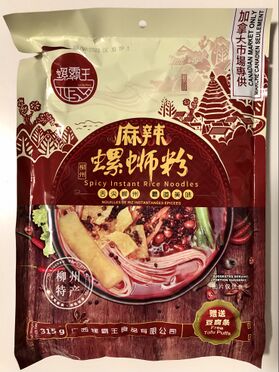
Ingredients
Based on our team's choice of pre-packaged Luosifen, it comes in the following flavouring packs.
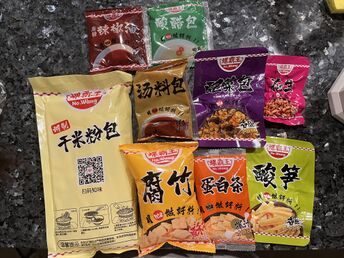
- Dry rice noodles
- Soup pack (river snail, pork bones and various spices)
- Auxiliary ingredients:
- Fermented bamboo shoots
- Yuba
- Peanuts
- Other unique side dish packs
- Seasoning:
- Chilli oil pack
- White vinegar pack
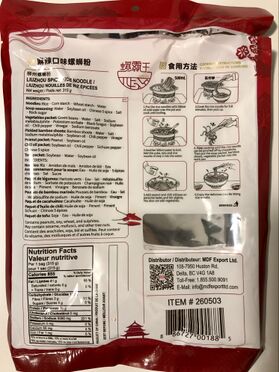
Nutrition Value
Nutrition Fact Table
| Amount | % Daily Value | |
|---|---|---|
| Calories | 855 | |
| Fat | 41g | 55% |
| Saturated | 0g | 0% |
| +Trans | 0g | 0% |
| Carbohydrate | 110g | |
| Fibre | 3g | 11% |
| Sugars | 5g | 5% |
| Protein | 10g | |
| Cholesterol | 0mg | |
| Sodium | 5090mg | 221% |
| Potassium | 0mg | 0% |
| Calcium | 55mg | 4% |
| Iron | 1mg | 6% |
Health Benefits
Bamboo shoots and yuba in the ingredient provide some health benefits to the clients. However, the benefits are very limited because of the small amount of yuba and bamboo shoot in Luosifen. The nutrition value does not meet the human body need.
Fermented bamboo shoot
Bamboo shoots are nutritious because of the fiber, copper, and vitamins B6 and E they contain.[1] Copper can provide benefits for skin health and brain function. Vitamin E, known as antioxidant, can protect against inflammation and chronic disease. Fermented bamboo shoots are rich in xylan or xylooligosaccharides. Therefore, they have various health benefits such as anti-oxidant, anti-cancer, and curing cardiovascular diseases.[2] Fermented bamboo shoots are also rich in cellulose[3], which can help improve digestion and weight loss.
Yuba
Yuba, which also called "tofu skin", is high protein, low fat, and low carbohydrate content. Besides, yuba is also rich in vitamins and minerals. Like other soy foods, yuba contains soy protein which can reduce cholesterol levels. Isoflavones and other antioxidants present in yuba can help women reduce menopause symptoms and signs of aging in skin.[4] With a moderate amount, yuba can help to lower risk of heart disease, lower risk of cancer, and is also good for our skin.
Health Concerns
Luosifen contains high oil and salt. The high oil coupled with the spicy taste can cause irritation to the stomach, which further cause health problems such as stomache and diarrhea.[3] From the nutrition fact table, we can see the sodium in one bag of instant Luosifen is 221% daily value, which means it exceeds human's daily need in a great amount. Having too much sodium in the diets can lead to high blood pressure, heart disease, and even stroke.[5] In addition, too much sodium can have influence the absorption of calcium, which is not good for our bone health. Therefore, although instant Luosifen is very easy to cook and the taste is very attractive to some people, it is not recommended to eat it very often. We can also reduce the amount of chilli oil pack to reduce the harm to our stomach.
Fermentation of Bamboo Shoots
Fermented bamboo shoot is an indispensable ingredient of Luosifen. It is responsible for Luosifen' signature and arguably off-putting scent.
Fermentation of bamboo shoots not only makes it palatable in terms of flavour, aroma, texture and appearance but also makes it highly nutritious and extends its shelf life because of the action of lactic acid bacteria making the product acidic and good for digestion[6]. Fermented bamboo shoots are widely eaten throughout Asia with varied preparation methods.
Preparation
Harvest and collect the bamboo shoots which have reached a height of 20 to 30 cms. Remove outer sheath of the shoots and then wash the soft, white portion and sliver the shoots for fermentation. Seal the slices in jars with pickling liquid for at least two months. The secret sauce of pickling is the mix of spring water and about 30% of aged pickle juice as an inoculum (traditionally fermented 2-year-old bamboo shoot) to fasten the process[7].
-
Fresh bamboo shoots
-
Cleaned bamboo shoots
-
Sliced bamboo shoots
-
Sliced bamboo shoots in jars
Chemical Reaction and Flavour
Formation of the Smell
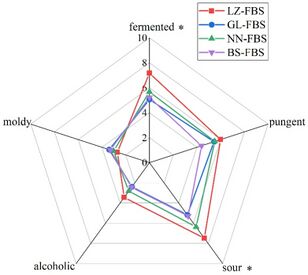
Fermentation is an anaerobic energy-producing process[8], which is why the slivered bamboo shoots need to be packed in an airtight container. In nature bacteria, yeast and even human cells use fermentation to create energy in the form of adenosine triphosphate (ATP) from sugar. During fermentation, glucose is split into a compound, called pyruvate through a process called glycolysis then depending on the organism, the pyruvate can go down one of two different fermentation pathways[9]. In the case of bamboo shoots, Pyruvate from glycolysis undergoes a simple redox reaction and forms lactic acid.
Lactobacillus is identified to be the functional microbes responsible for the production of organic acids (especially lactic acid) and characteristic volatile flavour compounds[10]. Clostridium_sensu_stricto_1, Enterobacter, and Leuconostoc were also vital for forming the unique flavour[10].
Aroma-Active Components
Researchers found a total of 70 volatile organic compounds that contributed to the unique smell and taste of fermented bamboo shoots[11][12][13].
A large GCO (gas chromatography olfactometry) p-cresol peak indicated that it was the most important aroma-active compound in bamboo[11]. p-cresol was the main fermentation byproduct of tyrosine, the major free amino acid in bamboo shoots[11]. It imparted a pungent, barn-like/medicine-like, phenolic odour to bamboo shoots.
Other important aroma-active components include 2-heptanol (mushroom-like), acetic acid (vinegar-like), (E)-2-nonenal (cucumber-like), 1-octen-3-ol (mushroom-like), linalool (lemon-like), guaiacol (phenolic, spicy), phenylethyl alcohol, creosol (burnt, earthy)[11][12][13].
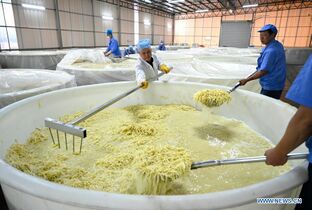
Other Factors
Fermented foods all have its unique flavour. The fermented bamboo shoots' sour and stinky smell is produced inevitably during the fermentation process by the aroma-active components named above. But other factors, such as exposure to oxygen, can "contaminate" the flavour, intensify the stinky smell.
The production process of fermented bamboo shoots is relatively extensive, especially when it comes to commerical use. Thus the fermentation environment is often not completely isolated from oxygen. After the cooperation of aerobic bacteria and anaerobic bacteria, the sugars and proteins in the bamboo shoots are fermented and converted into various amino acids and organic acids, aldehydes, alcohols and other substances. The cysteine and tryptophan in fermented bamboo shoots are consumed in large quantities, and the accumulation of hydrogen sulphide leads to its strong internal taste as the final product[14].
Reason for the Love of Smelly Foods
There are many desirable stinky foods around the world, such as douzhi, sauerkraut, stinky tofu, blue cheese, natto, shrimp paste and durian.
One of the reason people love stinky and pungent food might be the same reason as loving spicy food. When consuming capsaicin, the ingredient in chilli peppers that makes them spicy, it delivers a sensation of burning in any tissue with which it comes into contact[15]. When the brain feels pain, the body releases endorphins as a natural pain killer. Eating spicy food regularly makes people associate the pain of chilli pepper with the endorphins' pleasant rush[16]. Thus, people crave spicy food sometimes. Similarly, pungent smelly food is irritant, it brings excitement and endorphins' pleasant rush.
In addition, individuals’ smelling sensitivity varies with different chemicals[17]. Therefore, when two people smell the same bowl of Luosifen, one person may detect the stinky odour stronger than the other.
Also, many scientists agree that human responses to odours (olfactory responses) are learned[18]. Personal experience associated with specific odours gives odours unique meanings, making them pleasant or unpleasant. For example, those who have never tried durian might compare its smell to raw sewage and rotting flesh, which are not appetizing. However, after they overcome the smell and get to taste the sweet and creamy texture of durian, they will learn and memorize the smell of durian as a smell of delicious food, and forever separate it from raw sewage and rotting flesh.
Inconclusion, despite the smell in a food, for the food to be acceptable for large populations, its taste has to be desired.
Preservation & Package
Instant Luosifen is composed of different ingredients, so we separately analyzed the preservation methods and packaging of different ingredients.
Dry Rice Noodles
Dry Rice Noodles are typically preserved by using dehydration. At present, the most commonly used dehydration methods for rice noodles include: hot air drying, heat pump drying, and freeze drying.[19] The current study points out that freeze drying rather than hot air drying and heat pump drying has a better performance for the preservation of rice noodles, though rice noodle hot air drying at 30 °C can also produce comparable quality attributes.[19] By using such dehydration methods, the shelf life of dry rice noodles can be extended to 6 moths to 1 year.
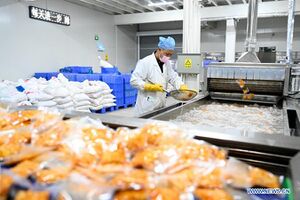
Fermented Bamboo Shoot
As mentioned above, fermentation not only brings more nutrients to the bamboo shoot, they would also give it a longer shelf life. The shelf life of fresh bamboo shoot is 3-4 days; however, A.K. Pandey and other researchers have conducted a large number of experiments by selecting bamboo shoot of different varieties.[20] They found Fermented Bamboo shoot is good in taste, texture and quality for 6 months. Form the photograph of ingredients, we can see that it is also dehydrated to extend the validity of the fermented bamboo shoot.
Other Auxiliary ingredients
Other Auxiliary ingredients to the as Yuba and peanuts are easy to have oxidative reactions, because they contain a lot of aerobic microorganisms. In order to prolong the shelf life of these Other Auxiliary ingredients, it is important to avoid contacting with the air, as the oxygen in the air increases their oxidative reactions. The vacuum greatly avoids these Other Auxiliary ingredients from contacting air; therefore, vacuum can extend their shelf life like Dry Rice Noodles and fermented Bamboo Shoot.
Packaging
Nowadays, aluminized laminated film and polyethylene film are mainly packaging materials used for instant Luosifen packaging. [21] We can see that from the graph, some ingredients are packaged by polyethylene film and others are packaged by the combination of these two kinds of film. Aluminized laminated film covered by polyethylene film can be moisture-proof. Dehydrated foods are hygroscopic due to its low water activity, so it's important that some ingredient, especially dried rice noodles, cannot be contacted with water vapour. It can also prevent outside intrusion of odor, so the flavor of Luosifen can be protected and reserved during its shelf life. Dehydrated rice noodles should be packaged to avoid oxygen and light, aluminized laminated film welly solved this problem. It acts as a oxygen barrier to avoid oxygen come into the bag. Some aerobic microorganisms such as bacteria are also the main reasons of the spoilage of Luosifen. The use of aluminized laminated film, therefore, can prevent the spoilage caused by the infusion of oxygen. What's more, the package of Luosifen is usually non-transparent, so it prevents the transmission of light.
Comparison
Before Luosifen was popular in the market, instant noodles such as Shin Ramyun were the first-choice instant food of many people. As another popular instant food that is very similar to Luosifen, we are going to explore the differences between their nutrition values and ingredients.
Nutrition Values
Overall, the nutrition amounts and daily values of Luosifen and Shin Ramyun are very similar. One difference is that Luosifen does not have saturated fats while Shin Ramyun has eight grams (40% DV) per bag. In fact, saturated fats can cause problems with cholesterol levels and increase risks with heart diseases. Thus, Luosifen does a better job by keeping saturated fats at zero grams. However, another difference is that the amount of sodium used in Luosifen (221% DV) is more than double the amount of sodium used in Shin Ramyun (86% DV), which exceeds the daily amount of sodium that a person should take by a large portion. As mentioned above, too much sodium intake can lead to high blood pressure, heart disease, and possibly stroke[5]. Lastly, Luosifen has zero percent potassium while Shin Ramyun contains around 350 milligrams (8% DV) for every bag. Potassium plays an important role in the function of kidneys, heart, muscles, and the transmission of messages through the nervous system. However, too much potassium intake can lead to health problems such as hyperkalemia[22]. Therefore, it is important to keep a balanced potassium intake and not exceed the daily limit that a person should take.
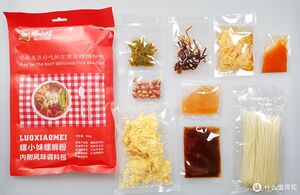
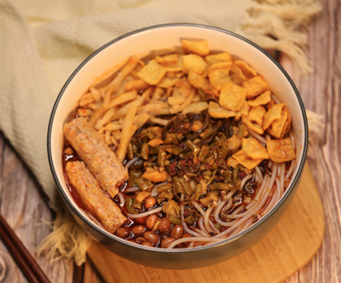
| Amount | % Daily Value | |
|---|---|---|
| Calories | 855 | |
| Fat | 41g | 55% |
| Saturated | 0g | 0% |
| +Trans | 0g | 0% |
| Carbohydrate | 110g | |
| Fibre | 3gg | 11% |
| Sugars | 5g | 5% |
| Protein | 10g | |
| Cholesterol | 0mg | |
| Sodium | 5090mg | 221% |
| Potassium | 0mg | 0% |
| Calcium | 55mg | 4% |
| Iron | 1mg | 6% |

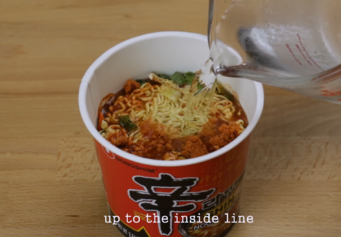
| Amount | % Daily Value | |
|---|---|---|
| Calories | 510 | |
| Total Fat | 16g | 21% |
| Saturated Fat | 8g | 40% |
| Trans Fat | 0g | |
| Polyunsaturated Fat | 1.5g | |
| Monounsaturated Fat | 6g | |
| Total Carbohydrate | 83g | 30% |
| Dietary Fiber | 3g | 11% |
| Total Sugars | 3g | |
| incl. Added Sugars | < 1g | 2% |
| Protein | 9g | |
| Cholesterol | 0mg | 0% |
| Sodium | 1970mg | 86% |
| Potassium | 350mg | 8% |
| Calcium | 30mg | 2% |
| Iron | 2.2mg | 10% |
Ingredients
Noodle
Luosifen and Shin Ramyun uses different types of noodles as their major source of carbonhydrates. Luosifen uses rice noodles while Shin Ramyun uses egg noodles. The main difference between rice noodles and egg noodles is how the noodle dough is made. Egg noodles are made by mixing eggs, wheat flour, and water together. By contrast, rice noodles are made using a mixture of rice flour, whole wheat flour, and water. Egg noodles tend to have a firmer, more slippery texture due to the extra protein content from the eggs. On the other hand, rice noodles are a lot softer than egg noodles, which allows them to absorb more broth and often take on the flavor of the broth itself[23]. One disadvantage of rice noodle is that it needs to be boiled in water more than 8 min depending on the perference of the firmness of noodle, while Shin Ramyun usually costs 5 min in boiled water or macrowave. Also, there are other brands of instant noodle can be cooked and fully soften just by sitting in hot water.
Other ingredients
Compared to Shin Ramyun which only has a soup pack and a dried vegetable pack (green onion, mushroom, bok choy, carrot, red chilli pepper), Luosifen has a lot more add-ons such as a chilli oil pack, a sour vinegar pack, yuba, and peanuts.
Exam question
What is the best method used in rice noddles preservation in pre-packaged Luosifen?
A. Freezing drying
B. Sun drying
C. Spray drying
D. Vacuum microwave drying
Answer: A. Freezing drying
Explaination: In the freeze drying process, water is removed from rice noddles in a frozen state without transitioning through the liquid state.
At the same time the rice noddles remains hard during the dehydration process and the sublimated water leaves voids where the ice crystals are located.
These voids give access to the liquid (like water) during rehydration and therefore freeze dried rice noddles do not cause the shrinkage and chemical changes that may occur in other
dehydration process (like sun drying). Spray driers are restricted to use with liquid foods since the principle of the operation is the introduction of the food as a spray of small droplets into a
high velocity stream of warm air. Vacuum microwave drying is technically superior to freeze drying, however it is too expensive to use for commercial instant food production.
References
- ↑ "Are Bamboo Shoots Good for You? All You Need to Know".
- ↑ Behera, Prapti (2021). "Health Benefits of Fermented Bamboo Shoots: The Twenty-First Century Green Gold of Northeast India". Applied Biochemistry and Biotechnology.
- ↑ 3.0 3.1 "Nutritional evaluation of Luosifen". zhihu.
- ↑ "Tofu skin "yuba" benefits, nutritional content, and how to make it". bitemybun.
- ↑ 5.0 5.1 "Salt and Sodium". hsph.harvard.edu.
- ↑ "Fermented bamboo shoots: A complete nutritional, anti-nutritional and antioxidant profile of the sustainable and functional food to food security". Food Chemistry: Molecular Sciences. Volume 3. 30 December 2021.
- ↑ Wang, Serenitie (8th November 2020). "How the 'durian of soup' became the hippest dish in China". CNN. Check date values in:
|date=(help) - ↑ "Fermentation".
- ↑ Sanford, Kiki (10 Feb 2017). "What Is Cool About Fermentation? - Food Science".
- ↑ 10.0 10.1 "The microbial succession and their correlation with the dynamics of flavor compounds involved in the natural fermentation of suansun, a traditional Chinese fermented bamboo shoots". Food Research International. Volume 157. July 2022.
- ↑ 11.0 11.1 11.2 11.3 "Aroma-Active Components in Fermented Bamboo Shoots". Journal of Agricultural and Food Chemistry. Volume 50. 2002.
- ↑ 12.0 12.1 "Determination of the Volatiles in Fermented Bamboo Shoots by Head Space – Solid-Phase Micro Extraction (HS-SPME) with Gas Chromatography – Olfactory – Mass Spectrometry (GC-O-MS) and Aroma Extract Dilution Analysis (AEDA)". Analytical Letters. Volume 54. 2021.
- ↑ 13.0 13.1 "Characterization of Key Aroma Compounds in Fermented Bamboo Shoots Using Gas Chromatography-Olfactometry-Mass Spectrometry, Odor Activity Values, and Aroma Recombination Experiments". Foods. Volume 11. 2022.
- ↑ "螺蛳粉为什么会臭?原来是因为它".
- ↑ "Capsaicin".
- ↑ "Why we learn to love spicy food".
- ↑ "Do you smell what I smell? From genes to receptors to perception: Olfaction unraveled". April 30, 2019. line feed character in
|title=at position 27 (help) - ↑ Herz, Rachel (October 1, 2001). "Ah, Sweet Skunk! Why We Like or Dislike What We Smell".
- ↑ 19.0 19.1 Ismail MH, Lik HC, Routray W, Woo MW. Determining the Effect of Pre-Treatment in Rice Noodle Quality Subjected to Dehydration through Hierarchical Scoring. Processes. 2021; 9(8):1309. https://doi.org/10.3390/pr9081309
- ↑ A.K. Pandey, Vijayalakshmi Ojha and S.K. Choubey, 2012. Development and Shelf-life Evaluation of Value Added Edible Products from Bamboo Shoots. American Journal of Food Technology, 7: 363-371. DOI: https://doi.org/10.3923/ajft.2012.363.371
- ↑ "Instant Noodle Packaging".
- ↑ Cherney, Kristeen. "Potassium". healthline.
- ↑ Morishita, Yuuna. "Are Ramen Noodles Rice Noodles?". The Japanese Way.
